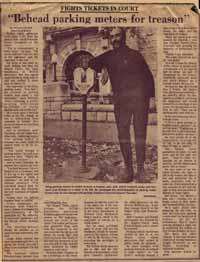SPCA looks for homes for abandoned dogs
Nelson Daily News
Sept. 15, 1975
Norman Johynson wold dearly love to get his hands on the people who abandoned the two dogs he found outside the central truck building Monday.
The hefty SPCA member makes a violent neck-wringing motion with his meaty hands, leaving no doubt about what he would like to do if the offenders were caught.
He found the two female German shepherds outside the building when he came to work Monday. they were so hungry, he says, they were eating mud.
He brought them inside the garage and fed them about a gallon of dog meal. Shortly after, the older dog vomited a mixture of mud and worms that looked like crank case oil on the cement floor.
Both dogs were about eight months old, he says, and probably unspayed. Nobody knows who abandoned them.
Both dogs bore signs of malnutrition and one had a serious case of distemper. They lay quietly on the cement floor licking Mr. Johnson’s hand when he patted them, obviously too ill to stand.
“That’s criminal,” said Mr. Johnson. “They depend so much on a human being.”
City poundkeeper Mike Popoff and Mr. Johnson took the two strays to the west Kootenay Animal Hospital that afternoon.
Dr. Hugh Croxall, a veterinarian, said the dogs will be kept alive because they may be needed as evidence in a court case if the former owners are found and charged.
Dr. Croxall says he has to destroy up to five dogs and eight cats per week for the city. He says the problem is one of education and overpopulation throughout North America.
Nelson, he says, “is a good dumping area” for dog owners who don’t want to pay the $5 fee to have their dog put to sleep.
Irresponsible dog owners have a peculiar rationale for abandoning their dogs in a city according to the veterinarian. “Some guy with a soft heart might take it, if the poundkeeper doesn’t destroy it or if it doesn’t get shot, or run over first.
They just seem to want to get rid of their problem but “if you doump a dog out on the road, it hasn’t just gone away— it’s still suffering.”
He says he regularly finds dogs tied to the hospital’s gate. Some of them have been shot, half drowned, run over and had their legs broken, or simply starved.
Though he’s under no legal obligation to take care of a dog because it’s tied to a gate, the poundkeeper will catch it anyway, and the hospital destroys strays found in the city.
A healthy dog may last two weeks in the hospital, in the hope that it can be given away for a pet. “But there just aren’t enough houses for all the dogs. Some will have to do without and it’s better for them to be put to sleep.”
Dogs that were pets can’t survive without people, he says.
“I despair of trying to educate these guys who say it’s wrong to tie up a dog os spay it — that it should be free. You’re interfering with the balance of nature. We protected the dog on one side of the scale, and now they’re overpopulated, but you can’t turn them back.”
Most stray dogs come to the hospital from outside of town, he says, and they get there by a pretty circuitous route.
“Big dogs have big litters.” Some dogs have as many as 12 pups per litter, he says, and the owners take the pups to a shoppign centre parking lot and give them away.
“So some innocent kid takes a dog home with him and the kids’s father takes it down to the dump and leaves it there.”
“You very rarely find the real offender, he says. That’s the one who gives the dog away.
Education, and limiting the number of animals is the ony to to do it,’ he says. “You can’t solve the problem by dealing with the cats and dogs.”


